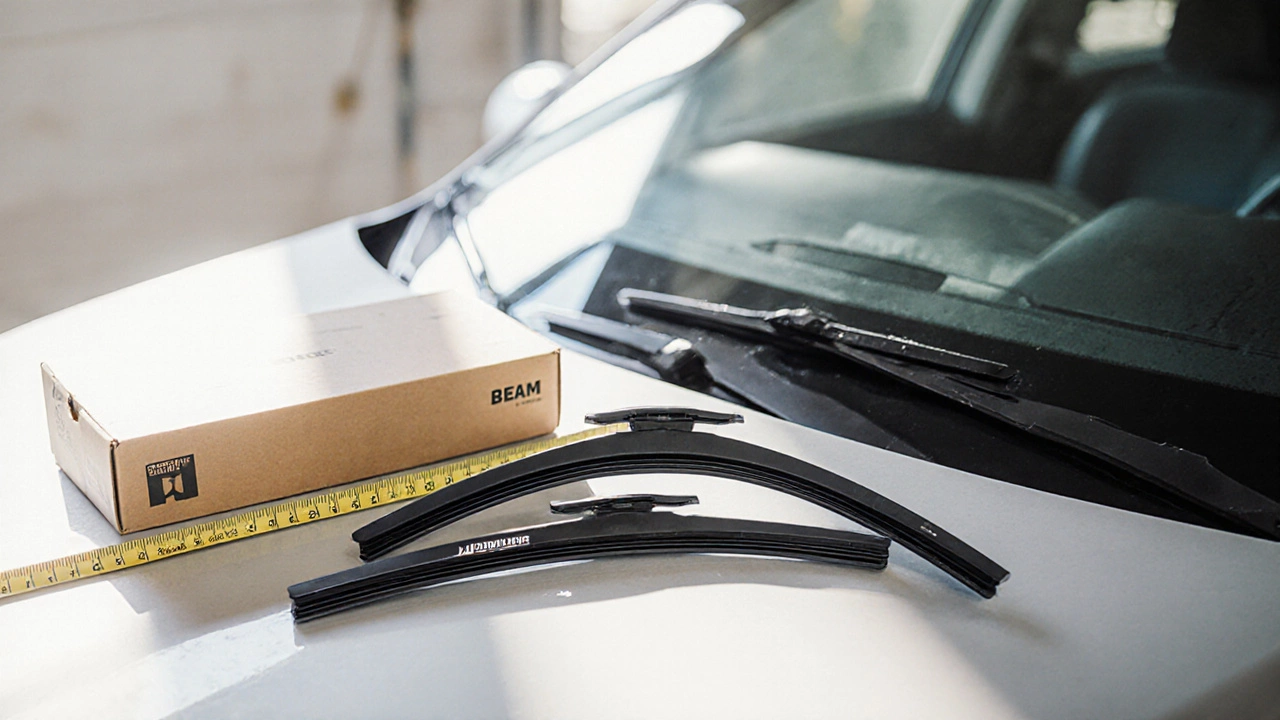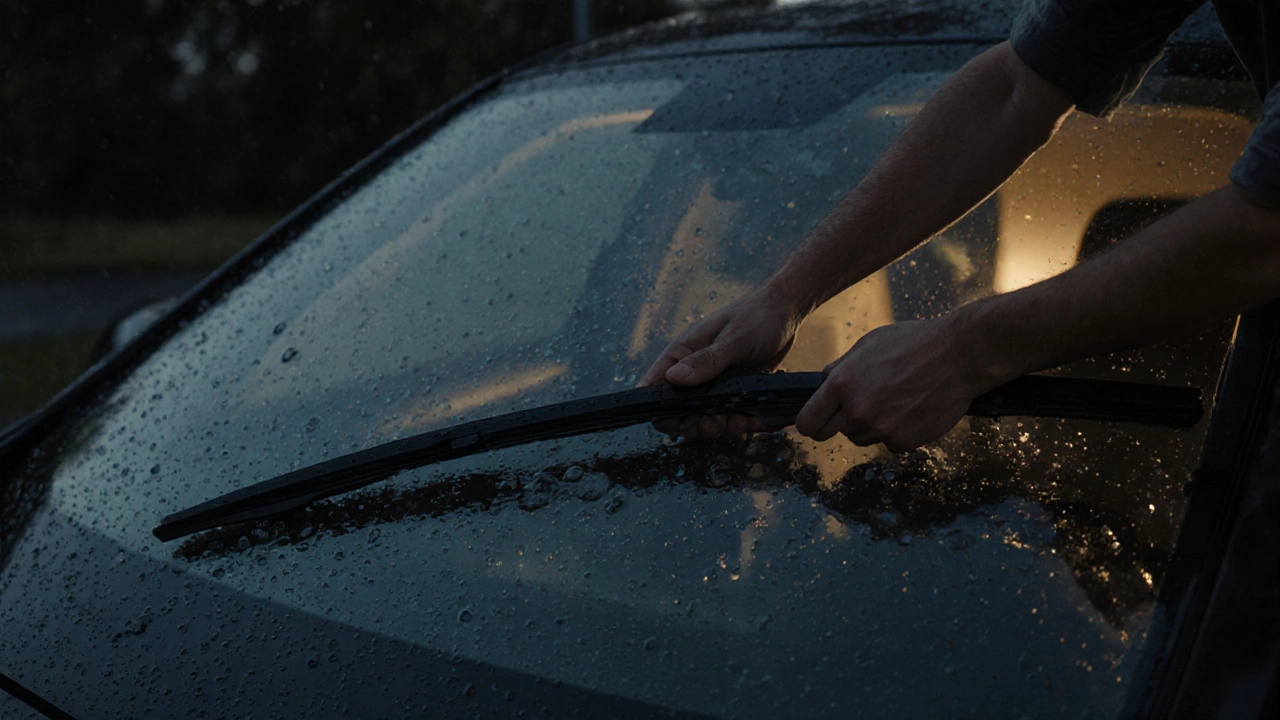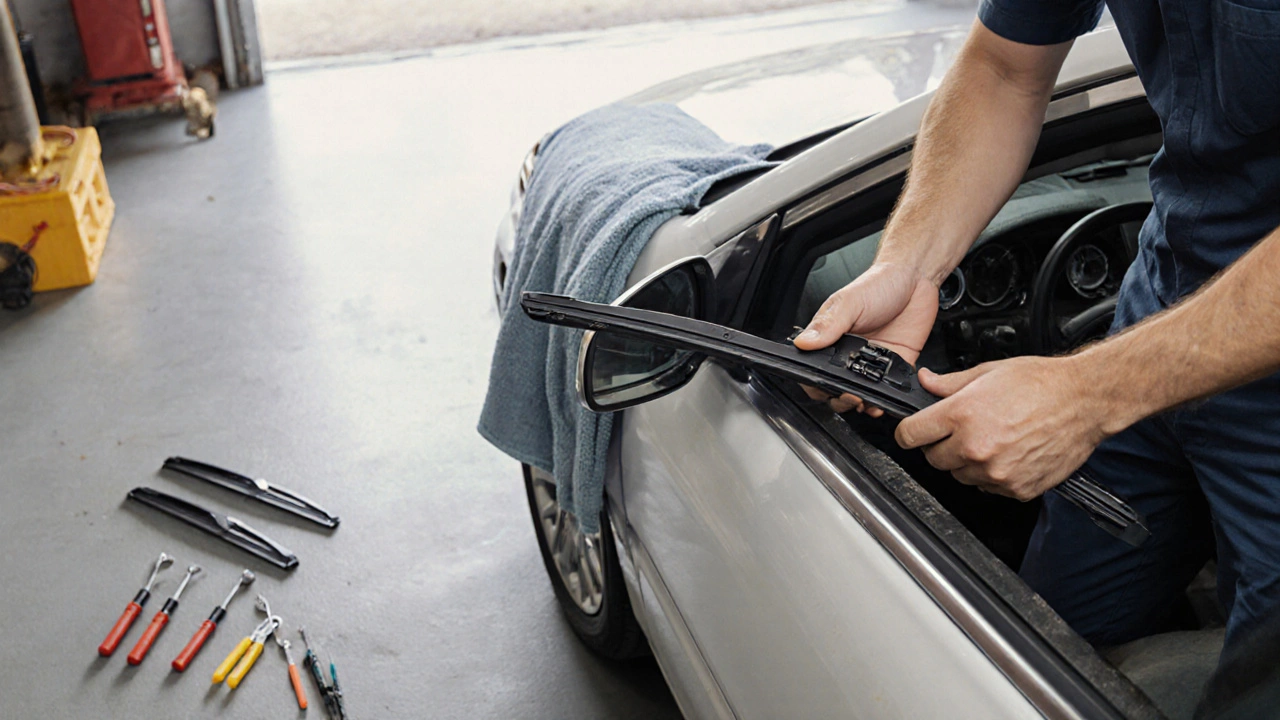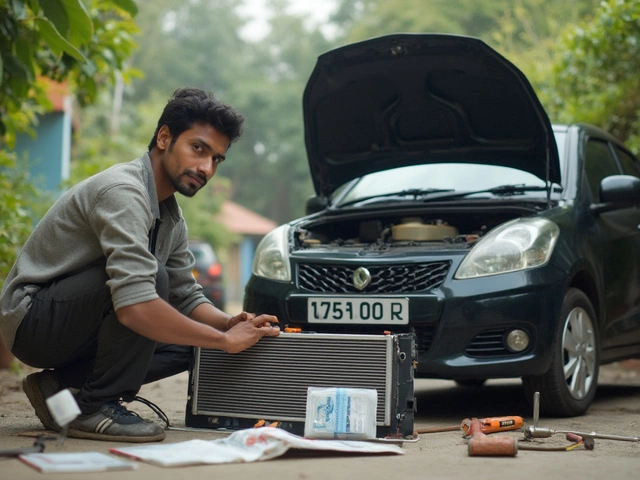Wiper Blade Size Finder
Find Your Perfect Wiper Blades
Get the exact wiper blade sizes for your car. Incorrect sizing can cause safety issues and poor performance.
Why Size Matters
Using incorrect wiper blade sizes can cause:
- Blades hitting the hood or A-pillar
- Reduced visibility due to incomplete coverage
- Damage to the wiper arms or windshield
- Safety hazards while driving in adverse weather
Ever been stuck in the rain with streaky, smearing windscreen wipers that barely clear the glass? It’s not just annoying-it’s dangerous. And before you head to the garage and pay $50 to swap out a couple of rubber blades, here’s the truth: windscreen wipers are one of the easiest car parts you can replace yourself. No special tools. No lift. No mechanic needed. Most people do it in under 10 minutes. If you’ve ever changed a light bulb or topped up your oil, you’ve already got the skills.
Why replacing wipers yourself makes sense
Wiper blades wear out. Not because they break, but because the rubber dries out, cracks, and loses its grip on the glass. Rain, sun, snow, and road grime eat away at them over time. Most manufacturers say to replace them every 6 to 12 months. If you notice streaks, chattering, or skipping-especially on the driver’s side-you’re already overdue.
Buying new blades from a store like AutoZone, Halfords, or Amazon costs between $8 and $25 for a pair. A mechanic might charge $40 to $70 just to install them. That’s a huge markup for a job that takes less time than brewing coffee.
And here’s the kicker: you don’t need to be a car expert. Even if you’ve never opened your hood, you can do this. There are no hidden screws, no electrical wires, no risk of damaging the windshield. Just rubber, metal, and a little patience.
How to pick the right wiper blades
Not all wiper blades are the same. You can’t just grab any pair off the shelf and hope it fits. The first thing you need is the correct size for your car. Most cars have two different sizes-one for the driver’s side, one for the passenger side. Some newer models even have a third, smaller wiper for the rear window.
Here’s how to find your size:
- Check your owner’s manual. It usually lists the exact measurements in inches.
- Use an online wiper blade size guide. Sites like Rain-X, Michelin, or AutoZone have tools where you enter your car’s make, model, and year.
- Measure the old blades. Pull them away from the windshield and lay them flat. Use a tape measure from end to end.
Don’t guess. A blade that’s too long can hit the hood or A-pillar. One that’s too short won’t clear enough of the glass. Both are safety hazards.
There are three main types of blades:
- Conventional blades: The old-school metal frame with multiple pressure points. Cheap and reliable, but can lift in high winds.
- Beam blades: Frameless design with a single curved spine. Better aerodynamics, more even pressure, and less prone to ice buildup. These are the most popular today.
- Hybrid blades: Combine features of both. A bit more expensive but offer good performance in all conditions.
For most drivers, beam blades are the best choice. They’re quieter, last longer, and handle snow and rain better.
Step-by-step: How to remove old wiper blades
Before you start, lift the wiper arm away from the windshield. Do it slowly. The arms are spring-loaded and can snap back hard if you’re not careful. If you’re worried about scratching the glass, place a towel over it before lifting.
Now, find the release mechanism. It’s usually a small plastic tab or button near the base of the blade where it connects to the hook on the wiper arm. The exact shape depends on your car, but here are the three most common types:
- Hook-style connector: Look for a small plastic tab on the underside of the blade. Press it down while pulling the blade away from the hook. You’ll hear a click.
- Pin-style connector: Some older cars have a metal pin sticking out. Push the pin inward and slide the blade off sideways.
- Bayonet-style connector: Twist the blade about 90 degrees while pulling down. It releases like a lightbulb.
Once the old blade comes off, don’t toss it yet. Keep it handy. You can use it as a reference when buying the new ones.

Installing the new wiper blades
Take your new blade out of the box. Most come with a protective plastic cover over the rubber-leave that on until you’re ready to install.
Match the connector on the new blade to the one on your wiper arm. If it’s a hook-style, slide the new blade’s connector onto the hook until you hear a solid click. Give it a gentle tug to make sure it’s locked in.
For pin-style or bayonet connectors, line up the parts and push or twist until they snap. Again, test the connection by pulling lightly.
Don’t force anything. If it doesn’t click or slide easily, you’ve got the wrong blade. Go back to the store and double-check the part number.
Once both blades are on, gently lower the arms back onto the windshield. Don’t let them slam down. You don’t want to crack the glass.
Test and fine-tune
Turn on the wipers. Use the washer fluid if you’ve got it. Watch closely. Do they move smoothly? Do they leave streaks? If you hear squeaking or see gaps in the wiping area, the blade might not be seated right.
Here’s a quick trick: if the blade is slightly misaligned, lift the arm again, release the blade, and reseat it. Sometimes a half-inch shift makes all the difference.
If the wipers still smear after a few passes, clean the windshield with rubbing alcohol and a microfiber cloth. Dirt and road film build up on the glass and can ruin even new blades.
Common mistakes to avoid
Even simple jobs go wrong when people rush. Here are the top five mistakes people make:
- Forgetting to lift the arm. Trying to pull the blade off while it’s pressed against the glass can bend the arm or scratch the windshield.
- Using the wrong size. Too long? It hits the hood. Too short? You can’t see half the road.
- Not testing the connection. A loose blade can fly off at highway speed. That’s not just dangerous-it’s illegal in many places.
- Installing in freezing weather. Cold rubber is brittle. If it’s below freezing, bring the blades inside for an hour first to warm them up.
- Skipping the washer fluid. Running dry wipers on a dirty windshield can tear the rubber instantly.

When to call a professional
There are rare cases where you shouldn’t DIY. If your wiper arm is bent, rusted, or doesn’t move smoothly, it might need replacing. That’s a bigger job. Same if the motor is failing-wipers stop mid-swipe or move too slow. Those issues need diagnosis.
Also, if your car has a special system like automatic rain-sensing wipers or a hidden rear wiper under a trim panel, you might want to check the manual or get help. Some newer models have complex mounting systems that aren’t meant for casual repair.
But for 95% of cars on the road today, replacing the blades is a beginner-friendly task. You don’t need training. You don’t need a manual. You just need the right blades and a few minutes.
How often should you replace them?
Replace your wipers every 6 to 12 months, no matter what. Even if they look fine, the rubber degrades with UV exposure and temperature swings. In places with hot summers or snowy winters, they wear out faster.
Keep a pair in your glovebox. If one blade fails suddenly on a rainy night, you can swap it out in the parking lot before heading home.
Pro tip: Mark the date on the packaging when you install them. Put a sticky note on the inside of your driver’s door. That way, you won’t forget.
Final thought: It’s not just about visibility
Good wipers aren’t a luxury. They’re a safety system. In heavy rain, your stopping distance doubles. If you can’t see clearly, you can’t react in time. Replacing your wipers isn’t a chore-it’s an insurance policy.
And the best part? You just saved yourself $50. Now go enjoy the view.
Can I use any brand of wiper blades?
Yes, as long as the size and connector type match your car. Brands like Bosch, Rain-X, Michelin, and Anco all make reliable blades. Avoid no-name brands from discount stores-they often have poor rubber quality and don’t last.
Do I need to replace both wipers at the same time?
Always. Even if only one is worn out, the other is close behind. Using mismatched blades causes uneven wiping, which strains the motor and reduces visibility. It’s cheaper and safer to do both at once.
Why do my new wipers chatter?
Chattering usually means the windshield is dirty or the blade isn’t seated properly. Clean the glass with rubbing alcohol. If that doesn’t help, remove the blade and reattach it, making sure it clicks fully into place. Sometimes the rubber needs a few passes to settle.
Can I replace just the rubber insert instead of the whole blade?
Some older blades allow rubber refills, but most modern ones don’t. Even if you can replace just the rubber, it’s rarely worth it. The frame can corrode, and the cost difference is small. Buying a new blade is faster and more reliable.
What if my wiper arm is bent?
A bent arm won’t hold the blade at the right angle, causing streaks or gaps. You can try gently bending it back with pliers, but it’s risky. Better to replace the entire arm. They’re usually under $30 and easy to install with a wrench.




